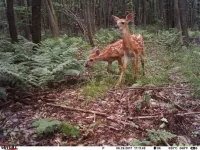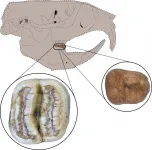(Press-News.org) Burnout. It is a syndrome that is said to afflict humans who feel chronic stress. But after conducting a novel study using trail cameras showing the interactions between white-tailed deer fawns and predators, a Penn State researcher suggests that prey animals feel it, too.
"And you can understand why they do," said Asia Murphy, who recently graduated with a doctorate from Penn State's Intercollege Graduate Degree Program in Ecology. "Less than half of whitetail fawns live to see their first birthday, and many are killed by predators, such as coyotes, black bears and bobcats. Fawns instinctively 'know' they are in constant danger."
Ironically, the presence of humans -- who mean the fawns no harm and likely would protect them if they could -- only ratchets up the stress the young animals experience, Murphy added. Even if it's just people hiking on a trail in a state park, it is a disturbance to be avoided by fawns, leaving less landscape and less time for them to feed and evade predators.
"The presence of people creates an environment where the danger seems so high that the animals basically stop having vigilance behaviors," she said. "That was the surprising thing about my research -- when fawns perceive that there is so much danger coming from so many sources, their behavior seemed like they just relaxed, like there's no point in being ready to hide or flee. I saw that in older deer, too."
In areas where there are many predators and people present, fawns seem to relax instead of acting hypervigilant, she noted.
"Like so much constant stress leaves them burned out," she said.
The goal of the study was to examine how human-dominated landscapes influence the timing, frequency and physical spacing and locations of interactions between humans, black bears, coyotes, bobcats and fawns, as well as to contrast deer vigilance behavior at each location. The researchers compared "camera trap" data from six surveys in and around three central Pennsylvania public forest sites with different surroundings -- forest, agriculture and development.
The Bald Eagle and Rothrock State Forest sites were surrounded by agriculture and low-density housing, whereas the Susquehannock State Forest site was surrounded by largely unbroken forest. Analyzing more than 10,000 photos, researchers observed markedly different behavior of fawns, adult deer and predators at the three locations, dictated, they suggest, by the presence of humans and their changes to the landscape.
Camera trap surveys began in mid- to late-May, which coincided with the start of the period when fawns are born and are most vulnerable to predation, and ended in mid-September, before the hunting season. Researchers randomly established 18 camera locations at each of the three study sites, spaced a minimum of a half mile apart within an area of about 100 square miles.
At least one camera was placed at each location and typically remained there for an average of 47 days before being moved to a new location. Cameras were set to take three pictures when triggered by an animal with a one-minute rest period. Each location was baited with a combination of bobcat urine, a skunk-based scent attractant and a fatty acid tablet.
In findings recently published in the Journal of Animal Ecology, the researchers reported that bears, bobcats, coyotes, fawns and adult deer all had more frequent timing overlaps in the agriculture and development sites compared to the mostly unbroken forest site. In addition, factors that influenced deer vigilance, such as distance to forest edge and predator abundance in the agriculture and development sites, were not factors in the mostly unbroken forest site.
"By taking into account the different antipredator behaviors that can be detected and the different scales at which these behaviors might occur, we were able to gain a more comprehensive picture of how humans reduce available niche space for wildlife," Murphy said. "It was clear that disturbed landscapes -- agriculture and development -- create more time and space overlap between predators and fawns."
This research is important because it is among the first to document that human land disturbance influences the dynamics of predator-prey interactions, according to Murphy's adviser, Duane Diefenbach, adjunct professor of wildlife ecology in the College of Agricultural Sciences. Wildlife biologists suspected human interference enhances opportunities for predators, but they had not seen proof.
"This study shows that antipredator behavior by fawns varies across space, time and predator species," said Diefenbach, who is leader of the U.S. Geological Survey's Pennsylvania Cooperative Fish and Wildlife Research Unit at Penn State. "When multiple predator species co-occur but vary in their use of space, time of activity and hunting mode, it creates a complex landscape for prey trying to avoid predation. Human presence has the potential to shift interactions among predators and prey and where and when encounters occur."
INFORMATION:
Also involved in the research was David Miller, associate professor of wildlife population ecology, Penn State, and Pennsylvania Game Commission biologists Mark Ternent and Matt Lovallo.
The Pennsylvania Game Commission funded and supported this research.
Researchers from Skoltech have found a way to help computer vision algorithms process satellite images of the Earth more accurately even with very limited data for training. This will make various remote sensing tasks easier for machines and ultimately the people who use their data. The paper outlining the new results was published in the journal Remote Sensing.
Researchers have been using computer vision and machine learning techniques to help with environmental monitoring for a while now. Tasks that may seem tedious and prone to human error are normally a piece of cake for algorithms. But before a neural network can successfully, say, discriminate between the kinds of trees in a forested area, it needs to be trained, ...
WHAT:
Among 6- and 7-year-olds who were born extremely preterm--before the 28th week of pregnancy--those who had more than two hours of screen time a day were more likely to have deficits in overall IQ, executive functioning (problem solving skills), impulse control and attention, according to a study funded by the National Institutes of Health. Similarly, those who had a television or computer in their bedrooms were more likely to have problems with impulse control and paying attention. The findings suggest that high amounts of screen time may ...
Leesburg, VA, July 15, 2021--According to ARRS' American Journal of Roentgenology (AJR), return to routine screening for BI-RADS 3 lesions on supplemental automated whole-breast US (ABUS) substantially reduces the recall rate, while being unlikely to result in adverse outcome.
"This prospective study supports a recommendation for routine annual follow-up for BI-RADS 3 lesions at supplemental ABUS," wrote lead author Richard G. Barr of Northeastern Ohio Medical University in Rootstown.
From August 2013 to December 2016, Barr and colleagues' prospective study (NCT02650778) ...
Undeniably the shark movie to end all shark movies, the 1975 blockbuster, Jaws, not only smashed box office expectations, but forever changed the way we felt about going into the water - and how we think about sharks.
Now, more than 40 years (and 100+ shark movies) on, people's fear of sharks persists, with researchers at the University of South Australia concerned about the negative impact that shark movies are having on conservation efforts of this often-endangered animal.
In a world-first study, conservation psychology researchers, UniSA's Dr Briana Le Busque and Associate Professor Carla Litchfield ...
About 70-80% of crop losses due to microbial diseases are caused by fungi. Fungicides are key weapons in agriculture's arsenal, but they pose environmental risks. Over time, fungi also develop a resistance to fungicides, leading growers on an endless quest for new and improved ways to combat fungal diseases.
The latest development takes advantage of a natural plant defense against fungus. In a paper published in Biotechnology and Bioengineering, engineers and plant pathologists at UC Riverside describe a way to engineer a protein that blocks fungi from breaking down cell walls, as well as a way to produce this protein in quantity for external application as a natural fungicide. The work could lead to a new way of controlling plant disease that reduces reliance on conventional ...
What are the fundamental skills that young children need to develop at the start of school for future academic success? While a large body of research shows strong links between cognitive skills (attention, memory, etc.) and academic skills on the one hand, and emotional skills on the other, in students from primary school to university, few studies have explored these links in children aged 3 to 6 in a school context. Researchers from the University of Geneva (UNIGE) and Valais University of Teacher Education, Switzerland (HEP-VS), in collaboration with teachers from Savoie in France and their pedagogical advisor, examined the links between emotion knowledge, cooperation, locomotor activity and numerical skills in 706 pupils aged 3 to 6. The results, to be read in the journal ...
Contamination of urban lakes, rivers and surface water by human waste is creating pools of 'superbugs' in Low- and Middle-Income Countries (LMIC) - but improving access to clean water, sanitation and sewerage infrastructure could help to protect people's health, a new study reveals.
Researchers studied bodies of water in urban and rural sites in three areas of Bangladesh - Mymensingh, Shariatpur and Dhaka. They found more antibiotic resistant faecal coliforms in urban surface water compared to rural settings, consistent with reports of such bacteria in rivers across Asia.
Publishing their findings in mSystems today, researchers from the University of Birmingham and the International Centre for Diarrhoeal Disease Research, Bangladesh call for further research to quantify the drivers ...
COVID-19 NEWS: CAN DIETARY SUPPLEMENTS HELP THE IMMUNE SYSTEM FIGHT CORONAVIRUS INFECTION?
Media Contact: Patrick Smith, pjsmith88@jhmi.edu
Johns Hopkins Medicine gastroenterologist Gerard Mullin, M.D., and a team of co-authors published an article May 11, 2021, in Advances in Experimental Medicine and Biology that details the scientific rationale and possible benefits -- as well as possible drawbacks -- of several dietary supplements currently in clinical trials related to COVID-19 treatment.
According to business analysts, the U.S. nutritional supplement industry grew as much as 14.5% in 2020, due in large part to the COVID-19 pandemic.
Mullin, associate professor of medicine at the Johns Hopkins University ...
GAINESVILLE, Fla. --- Two fossil teeth from a distant relative of North American gophers have scientists rethinking how some mammals reached the Caribbean Islands.
The teeth, excavated in northwest Puerto Rico, belong to a previously unknown rodent genus and species, now named Caribeomys merzeraudi. About the size of a mouse, C. merzeraudi is the Caribbean's smallest known rodent and one of the region's oldest, dating back about 29 million years.
It also represents the first discovery of a Caribbean rodent from a North American lineage, a finding that complicates an idea ...
A new study by the University of Malta and Staffordshire University highlights an urgent need for change in the curriculum and demonstrates how introducing longer, more frequent and more physically intense PE lessons can significantly improve children's weight and overall health.
Malta currently has one of the highest rates of obesity worldwide with 40% of primary and 42.6% of secondary school children being overweight or obese.
The World Health Organization (WHO) recommends that children engage in at least 60 minutes of age-appropriate moderate-to-vigorous physical activity (MVPA) daily, however ...




